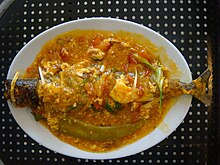| This article needs additional citations for verification. Please help improve this article by adding citations to reliable sources. Unsourced material may be challenged and removed. Find sources: "Escabeche" – news · newspapers · books · scholar · JSTOR (November 2009) (Learn how and when to remove this message) |
 Escabeche of Spanish mackerel, from the Philippines Escabeche of Spanish mackerel, from the Philippines | |
| Region or state | Mediterranean, Latin America, the Philippines, Guam |
|---|---|
| Main ingredients | Fish, meat or vegetables |
| Ingredients generally used | Vinegar, paprika, or saffron |
| Variations | Brathering |

Escabeche is the name for several dishes in Spanish, French, Portuguese, Italian, Filipino and Latin American cuisines, consisting of marinated fish, meat or vegetables, cooked or pickled in an acidic sauce (usually with vinegar), and flavored with paprika, citrus, and other spices.
In both Spain and Latin America, many variations exist, including frying the main ingredient before marinating it. Escabeche of seafood, fish, chicken, rabbit, pork, and vegetables are common in Spain, Caribbean and Portugal. Eggplant escabeche is common in Argentina.
Terminology
The Spanish and Portuguese word escabeche originates from Andalusi Arabic (spoken in Muslim Iberia) and ultimately Persian. It is derived from al-skepaj (السكباج), the name of a popular meat dish cooked in a sweet-and-sour sauce, usually containing vinegar and honey or date molasses. This technique spread throughout the former Portuguese and Spanish Empires and is particularly common in Latin America and the Philippines.
The dish is known as escoveitch, escoveech or escovitch fish in Jamaica and is marinated in a sauce of vinegar, onions, carrots, and Scotch bonnet peppers overnight. It is known as scapece or savoro in Italy, savoro in Greece (especially Ionian islands), and scabetche in North Africa.
Variations
Escabeche is common in Spain and has evolved with local modifications in the Spanish-speaking world. It is well represented in Portugal, frequently by the name Molho à Espanhola ("Spanish sauce"), usually spiced with peppercorns, chilis, peppers, onions, garlic and sliced carrots. The dish is popular in the Philippines and Guam, both former Spanish colonies, where it is the closest to the original Spanish version: using fish that is locally available but respecting the original technique.
In international versions like in Peru, escabeche is usually poached or fried, then served cold after marinating in a refrigerator overnight or longer. The acid in the marinade is usually vinegar but can include citrus juice (a common conservation technique—a pH of 4 or lower effectively stops rotting). Escabeche is a popular presentation of canned or potted preserved fish, such as mackerel, tuna, bonito, or sardines.
Fish escabeche is also a Filipino cuisine version of sweet and sour fish. The dish is marinated in a fusion of ginger, vinegar-water, sugar, carrot, red bell pepper, ground pepper, onion and garnished with atchara. In José Rizal's July 1892 Dapitan exile, the letters in his novels mentioned fish escabeche as part of merienda cena, including tinolang manok, tsokolate, suman malagkit, tinagaktak, Leyte's salvero, a Pan Bisaya.
See also
- Arsik
- Brathering, a German version
- Ceviche, raw fish in an acidic marinade
- Kelaguen
- Nanbanzuke
- Sweet and sour
References
- ASALE, RAE-; RAE. "escabeche | Diccionario de la lengua española". «Diccionario de la lengua española» - Edición del Tricentenario (in Spanish). Retrieved 2020-12-07.
- Medieval Arab Cookery, Maxime Rodinson, A. J. Arberry, and Charles Perry. ISBN 0-907325-91-2.
- "Escabeche (Sweet and Sour Fish)". Genius Kitchen. Retrieved 5 April 2018.
- Lagasse, Emeril. "33 Spanish Starters". 33 Spanish Starters. Food Network UK. Food Network, n.d. Web. 29 Dec. 2015.
- "Fish Escabeche". ABS-CBN News and Current Affairs. January 24, 2024. Retrieved July 12, 2024.
- "'Tinolang manok,' fish 'escabeche,' 'suman malagkit,' 'tinagaktak'–Rizal's fare in Dapitan". Philippine Daily Inquirer. June 30, 2011. Retrieved July 12, 2024.
